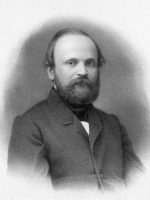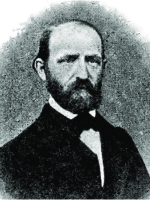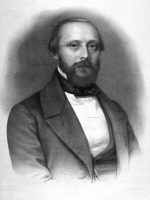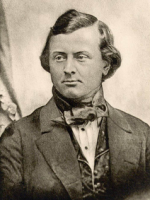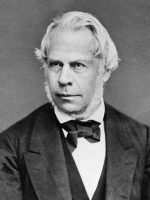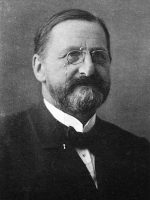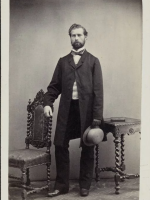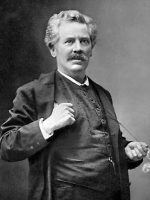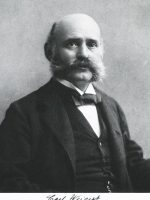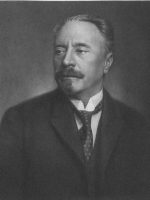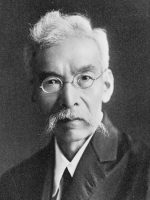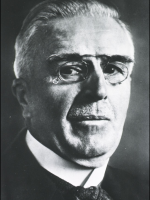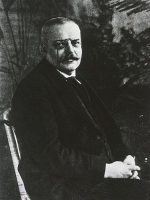Classic papers
The concept of neuroglia was introduced by Rudolf Virchow in 1856. Virchow conceived neuroglia as a kind of connective tissue and found that this tissue also contained cellular elements. However, the first glial cell was described even before Virchow drafted his neuroglia concept. Robert Remak had described nerve fibers and their surrounding sheats, later on called Schwann Cells, in his thesis published in 1838. Heinrich Müller described cells which were named after him, the Müller cells and published the first drawings of these radial glial cells in Würzburg in 1851. We owe the first drawings of a star shaped glial cell to Otto Deiters who died at a young age and whose work was published posthumously in 1865. Some years later Jacob Henle and Friedrich Merkel produced drawings of glial networks in the gray matter.
Pio del Rio Hortaga, a student of Cajal, finally succeded in defining the three glial cell types in the central nervous system. In a series of publications he was able to distinguish microglial cells and oligodendrocystes from astrocytes, and since then we know these three major types of glial cells in the central nervous system.
Robert Remak (1815 – 1865) describes axons and their ensheathments in his doctoral thesis in Latin published in 1836. Thus, the figures showing these ensheathments are the first image of glial structures more than 20 years before Virchow’s image of glial cells.
In his publication from 1836 in Müllers Archiv (pages 145-161) Remak gives a detailed description in German. He distinguishes between ´markhaltigen´ (myelinated) and ´marklosen´ (unmyelinated) axons and also mentions and depicts ´Einschnürungen´ (constrictions, possibly the node of Ranvier?) of the myelinated fibers. For the diameter of the axons he reports between 0.0003 to 0.006 Englsh lines (one English Line is equivalent to 2.5 mm).
This book contains all publications by Heinrich Müller including the article with the first description of the Müller cells. (Müller, H. (1851) Zur Histologie der Netzhaut. Z. Wissenschaft. Zool. 3: 234-237) It also contains a biography of Müller. The book was published after his death in 1872
Sometimes confusing in the literature is the origin of the word „glia“. In some publications it is related to an article by Rudolf Virchow (1821-1902) published in 1846 about brain ventricles (Über das granulierte Aussehen der Wandungen des Gehirnvenrtikels, Zeitschrift für Psychiatrie, Heft 2, 242ff). He re-published the article in his collected works in (Gesammelte Abhandlungen zur wissenschaftlichen Medizin, Frankfurt, 1856) and there he added a comment to this article where the term „glia“ appears for the first time.
Rudolf Virchow’s book „Cellularpathologie“, Hirschwald, 1858 ( Cellular pathology ) is generally considered as the start of the glial field. It certainly is a landmark publication in medicine. It is a series of 20 lectures held at the Berlin University which were steno typed and published.
Karl Bergmann (1814-1865) from Rostock noted fibers in the cerebellum and he gave his name to the Bergmann glial cells. It was an article in Zeitschrift für Rationelle Medicin (8:360-363) in 1857.
In the book „Untersuchungen über Gehirn und Rückenmark, Vieweg“ (Investigations on brain and spinal cord) by Otto Deiters (1834-1863) is probably the first image of an astrocyte from the brain. Published in 1865.
An article by Jacob Henle (1809-1885) and his son-in-law Friedrich Merkel (1845 – 1919) shows for the first time, the network of astrocytes in the brain. It was published in Zeitschrift für Rationelle Medicin, 34:49-82, 1869.
Carl Frommann (1831 – 1892) from Jena recognized pathologic glial cells in human Multiple Sclerosis tissue in the publication ´Untersuchungen über die Gewebsveränderungen bei der Multiplen Sklerose des Gehirns und Rückenmarks`,Gustav Fischer, 1878.
Gustav Retzius (1842 –1919) published two chapters in his book series „Biologische Untersuchungen“ (Biological Investigations) which contain excellent drawings of glial cells from different species (Retzius, G. Studien über Ependym und Neuroglia. Biologische Untersuchungen 5:2-26, Stockholm, (1893)
This chapter describes further contributions to the anatomy of glial and ependymal cells with the focus on lower vertebrates, Biologische Untersuchungen 19:1-26, Stockholm, 1921.
The book by Carl Weigert (1845-1904) is the first book entirely devoted to glial cells (Weigert, K. (1895) Beiträge zur Kenntnis der normalen menschlichen Neuroglia, Diesterweg, Frankfurt).
Michael von Lenhossek (1863-1937) coined the term „astrocyte“ in the second edition of the book „Der Feinere Bau des Nervenssystems im Lichte neuerer Forschung“,Gustav Fischer, 1895.
Katsusaburo Yamagiwa (1863-1930) was a Japanese pathologist working at the Imperial University of Tokyo. He got inspired on glial research by Rudolf Virchow since he spent four years (1891-1895) in his laboratory in Berlin. In this article he describes a novel staining procedure for neuroglia (Virchows Archiv 160: 358 365, 1900). He was a pioneer in cancer research and being first to prove chemical carcinogenesis.
Hans Held (1866-1942) published the second book devoted to glia ´Über den Bau der Neuroglia und über die Wand der Lymphgefäße in Haut und Schleimhaut´, Teubner, 1903. His name is also connected to the largest synapse in the brain, the Calyx of Held
This book chapter by Alois Alzheimer (1864-1915) (Beiträge zur Kenntnis der pathologischen Neuroglia und ihrer Beziehung zu den Abbauvorgängen im Nervengewebe, Alzheimer, A. In: Histologische und Histopathologische Arbeiten über die Grosshirnrinde (F. Nissl and A. Alzheimer, eds,Gustac Fischer, 1910) gives a good account on pathologic glia.
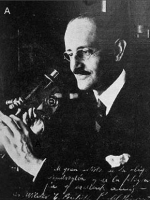
Pio del Rio Hortega (1882 – 1945) described and characterized oligodendroglia cells in a seminal article in 1921, albeit he had already mentioned the existence of a new cell type of neuroglia –the interfascicular glia- showing very fine processes, when describing microglia in his first publication on “the third element” in 1919. In that article of 1921 “Studies on Neuroglia- The few radiation glia (Oligodendroglia)” he also advanced its relation with myelination and described its development. A second article followed in 1922 supporting the possibility of these cells could be the homologous with Schwann cells in the central nervous system and a third contribution appeared in 1928 offering full details and a thorough review. Since all of the mentioned articles were published in Spanish and also likely due to terminological confusion, the discovery of oligodendroglia by Río-Hortega has not been so widespread internationally recognized as his discovery of microglia has. Therefore, we have aimed at making available the process of discovery and description of oligodendroglia by Río-Hortega offering the first English version of the two original articles on oligodendroglia published by him in 1921 and 1922 and also at paying a posthumous homage to this great Spanish histologist and neuropathologist. The compilers would like to thank Prof. Manuel J. Gayoso, director of Río-Hortega museum at the University of Valladolid, Spain and Mrs. Mª Angeles Langa, librarian of the Cajal Institute in Madrid for their facilities and help in obtaining the original articles. Authorized by José R. Iglesias-Rozas, Manuel Garrosa, Manuel J. Gasyoso and Juan del Rio-Hortega Bereciartu

